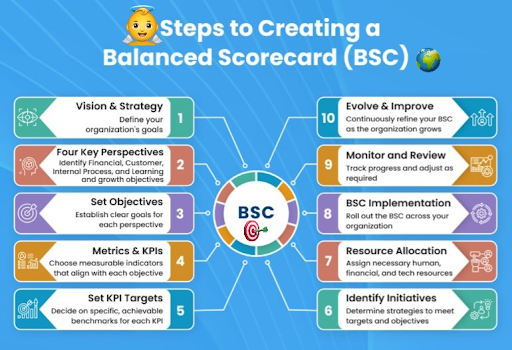101 Ways to Manage Corporate Performance with a Balanced Scorecard in 2024
Managing corporate performance effectively is essential for any business aiming for long-term success. In 2024, one of the most comprehensive and strategic approaches to performance management is the Balanced Scorecard (BSC). The Balanced Scorecard provides a framework that translates an organization’s strategic objectives into a set of performance measures across four perspectives: Financial, Customer, Internal Processes, and Learning and Growth. Here, we'll explore 101 ways to manage corporate performance using the Balanced Scorecard in 2024.
Financial Perspective
- Revenue Growth: Track year-over-year revenue increases.
- Cost Management: Monitor cost reduction initiatives and their impact.
- Profit Margins: Measure profit margins to assess financial health.
- Return on Investment (ROI): Calculate ROI for all major projects.
- Economic Value Added (EVA): Evaluate the economic profit after deducting the cost of capital.
- Budget Adherence: Ensure departments adhere to their budgets.
- Cash Flow Analysis: Regularly analyze cash flow statements.
- Debt Management: Monitor and manage corporate debt levels.
- Dividend Payouts: Track dividend distributions to shareholders.
- Expense Ratios: Measure expenses as a percentage of revenue.
Customer Perspective
- Customer Satisfaction: Conduct regular customer satisfaction surveys.
- Net Promoter Score (NPS): Use NPS to gauge customer loyalty.
- Market Share: Track changes in market share.
- Customer Retention Rate: Measure the percentage of retained customers.
- Customer Acquisition Cost (CAC): Calculate the cost to acquire a new customer.
- Customer Lifetime Value (CLV): Estimate the total value of a customer over their lifetime.
- Churn Rate: Monitor the rate at which customers stop doing business with you.
- Customer Complaint Resolution: Track the efficiency of resolving customer complaints.
- Brand Awareness: Measure brand recognition and perception.
- Customer Segmentation: Analyze performance across different customer segments.
Internal Processes Perspective
- Process Efficiency: Measure the time and cost of core processes.
- Cycle Time Reduction: Track efforts to reduce the time taken for critical processes.
- Quality Control: Monitor defect rates and quality assurance measures.
- Innovation Rate: Measure the rate of new product or service introductions.
- Supply Chain Management: Track supply chain performance and reliability.
- Operational Flexibility: Assess the organization’s ability to adapt to changes.
- Safety and Compliance: Monitor adherence to safety standards and regulations.
- Production Downtime: Measure the amount of downtime in production processes.
- Capacity Utilization: Track how efficiently production capacity is utilized.
- Waste Reduction: Implement and monitor waste reduction initiatives.
Learning and Growth Perspective
- Employee Engagement: Conduct regular employee engagement surveys.
- Training and Development: Track investment in employee training programs.
- Skill Assessment: Measure the skill levels of employees against required competencies.
- Leadership Development: Monitor leadership training and development initiatives.
- Employee Turnover Rate: Track the rate of employee turnover.
- Internal Promotion Rate: Measure the rate of promotion from within.
- Knowledge Management: Assess the effectiveness of knowledge-sharing systems.
- Innovation Capacity: Track the number of ideas generated and implemented.
- Technology Utilization: Measure the adoption and effective use of new technologies.
- Cultural Alignment: Ensure organizational culture aligns with strategic objectives.
Strategy Alignment
- Strategy Maps: Develop and regularly update strategy maps.
- Strategic Initiatives: Track the progress of strategic initiatives.
- Balanced Scorecard Integration: Ensure BSC is integrated into the management process.
- Communicate Strategy: Regularly communicate the strategy to all employees.
- Align Objectives: Align individual and departmental objectives with corporate strategy.
- Performance Reviews: Conduct regular performance reviews based on BSC metrics.
- Cross-Departmental Collaboration: Encourage collaboration between departments.
- Benchmarking: Compare performance against industry benchmarks.
- Continuous Improvement: Foster a culture of continuous improvement.
- Strategic Planning: Regularly review and update the strategic plan.
Technology and Tools
- Performance Management Software: Utilize BSC software for tracking and reporting.
- Data Analytics: Use data analytics to gain insights from BSC metrics.
- Dashboards: Develop dashboards to visualize performance metrics.
- Automated Reporting: Implement automated reporting systems.
- Cloud Solutions: Use cloud-based solutions for real-time data access.
- Mobile Accessibility: Ensure BSC tools are accessible via mobile devices.
- Cybersecurity: Implement robust cybersecurity measures.
- AI Integration: Leverage artificial intelligence for predictive analytics.
- Big Data: Utilize big data for deeper performance insights.
- Collaboration Tools: Use collaboration tools to enhance team communication.
Innovation and Creativity
- Idea Management Systems: Implement systems for capturing and managing ideas.
- R&D Investment: Track investment in research and development.
- Prototype Testing: Measure the success rate of prototypes and pilots.
- Customer Feedback Loop: Use customer feedback to drive innovation.
- Open Innovation: Encourage open innovation with external partners.
- Hackathons: Organize hackathons to spur creativity.
- Innovation Workshops: Conduct workshops to generate new ideas.
- Fail Fast Culture: Promote a culture that encourages experimentation and accepts failure.
- Crowdsourcing: Use crowdsourcing for innovative solutions.
- Innovation KPIs: Develop KPIs specifically for innovation.
Leadership and Management
- Leadership KPIs: Develop performance metrics for leaders.
- Transparent Leadership: Ensure leadership practices transparency.
- Decision-Making Speed: Measure the speed and quality of decision-making.
- Leadership Communication: Track the effectiveness of leadership communication.
- Crisis Management: Evaluate the effectiveness of crisis management strategies.
- Ethical Leadership: Monitor adherence to ethical standards.
- Mentorship Programs: Implement and track mentorship programs.
- Leadership Diversity: Promote and measure leadership diversity.
- Succession Planning: Develop and monitor succession plans.
- Leadership Feedback: Collect feedback on leadership performance.
Customer-Centric Strategies
- Customer Journey Mapping: Map and optimize the customer journey.
- Personalization: Track the effectiveness of personalization strategies.
- Customer Experience (CX): Measure and improve CX.
- Loyalty Programs: Monitor the performance of loyalty programs.
- Customer Advocacy: Foster and measure customer advocacy.
- Omni-Channel Strategy: Implement and track omni-channel customer engagement.
- Social Listening: Use social listening to understand customer sentiment.
- Customer Education: Provide and measure the impact of customer education programs.
- Value Proposition: Ensure your value proposition is clear and compelling.
- Customer-Centric Culture: Foster a culture that prioritizes customers.
Sustainability and Social Responsibility
- Sustainability Metrics: Develop and track sustainability metrics.
- Corporate Social Responsibility (CSR): Measure the impact of CSR initiatives.
- Environmental Impact: Monitor and reduce environmental impact.
- Ethical Sourcing: Track ethical sourcing practices.
- Community Engagement: Measure community engagement efforts.
- Diversity and Inclusion: Promote and track diversity and inclusion initiatives.
- Sustainable Innovation: Innovate with sustainability in mind.
- Carbon Footprint: Monitor and reduce your carbon footprint.
- Social Impact Investing: Track investments in social impact projects.
- Sustainability Reporting: Regularly report on sustainability performance.
Review and Adaptation
- Performance Reviews: Conduct quarterly and annual reviews of BSC metrics.
- Adapt Strategies: Be prepared to adapt strategies based on performance data.
- Feedback Loop: Establish a continuous feedback loop for improvement.
- Stakeholder Engagement: Regularly engage with stakeholders for input.
- Agile Methodologies: Apply agile methodologies for rapid adaptation.
In 2024, the Balanced Scorecard remains a powerful tool for managing corporate performance. By focusing on these 101 ways to implement and enhance the Balanced Scorecard, organizations can ensure they are well-positioned to achieve their strategic objectives and thrive in a competitive environment.





No comments:
Post a Comment